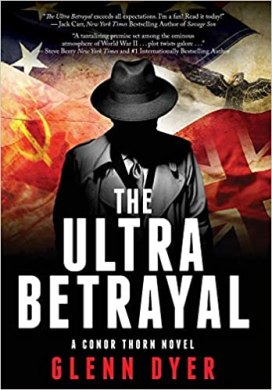
“Brilliantly researched and filled with fascinating characters from the pages of history, Glenn Dyer once again brings World War II espionage to life in his latest Conor Thorn thriller.“
That’s how New York Times bestselling author Jack Carr described The Ultra Betrayal, the latest page-turner from Glenn Dyer, a must-read for espionage enthusiasts everywhere.
One man’s dark deal with the Nazis could bring the Allies to their knees. . .
The story, which follows OSS Agent Conor Thorn, kicks off when a key Swedish cryptographer stationed in England goes missing. believed to be in possession of critical intelligence, Thorn is tasked with finding the man at all costs. Things, however, don’t exactly go according to plan, and before he knows it, Thorn winds up smack-dab in the middle of a Nazi conspiracy that could change the world as he knows it.
Dyer’s series, which started with The Torch Betrayal, is one one of the more underrated spy franchises set during WWII, and a perfect fit for fans of Alan Furst. And Conor Thorn is a really fantastic hero, who doesn’t get the attention he deserves.
This time around, with his latest release, I caught up with Dyer just after his new book came out, and I asked him about everything from how he came up with the story idea for this book to what his writing process is like.
See the full Q&A below, then click here to order your copy of The Ultra Betrayal, now available in hardcover, paperback, and ebook.

TRBS: First and foremost, how did you come up with the story idea for The Ultra Betrayal?
Dyer: Given my general interest in history, specifically World War II, I have countless books, fiction and nonfiction, that delve into various aspects of the conflict—aspects that are broad and some that are much narrower in scope. It was one such story that was briefly mentioned in Anthony Cave Brown’s book Bodyguard of Lies that inspired The Ultra Betrayal.
The story starts in June of 1938. Stewart Menzies (pronounced Mingiz), then a deputy to the head of Britain’s MI6, Admiral Hugh Sinclair, received word from Major Harold Lehrs Gibson, head of station for MI6 in Prague, that he had, with the help of the Polish intelligence service, met a Polish Jew who was a mathematician and engineer that worked in a Berlin factory where Enigma machines were built. (Cave Brown assigned the name Richard Lewinski to this person but noted that it was a pseudonym.) Being Jewish, he had been fired and expelled from Germany, and most importantly, he was willing to sell his knowledge of the Enigma machine to the British.
The engineer set his price: £10,000, a British passport, and a resident’s permit for France, where he wanted to settle—not England as he didn’t have any family or friends there. In exchange, he offered to build a replica of the Enigma machine and draw up diagrams of the internal wiring system.
After the engineer’s knowledge was vetted in person by Alfred Dilly Knox, a highly-skilled cryptologist whose experience in code-breaking went back to World War I, and his assistant, Alan Turing—both assigned to Bletchley Park—they recommended to Menzies that he agree to the engineer’s terms.
Lewinski, along with his wife, traveled on British laissez-passer documents from Poland to Sweden, then to Paris, France. There, in an apartment on the Left Bank of the Seine River, he fulfilled his end of the agreement and built an imitation of the Enigma machine.
Fast-forward to May of 1940. The German Wehrmacht swept through Belgium, the Netherlands, and France, employing “lightning war” or Blitzkrieg tactics. With the Germans drawing close to Paris, causing the ultimate collapse of the British Expeditionary Force and French forces, Menzies, along with Frederick Winterbotham, who was charged with the overall security of Ultra, realized that they needed to evacuate all personnel from France who had any involvement in Ultra, along with any equipment and documentation. Among those evacuated were Lewinski and his wife.
Cave Brown went on to state that Lewinski was given lodgings by MI6 and put under police guard when they arrived in London.
“Then he disappeared . . . Whatever happened, Lewinski left no trace.”
This disappearance of someone with a great deal of knowledge about British code-breaking capabilities is what inspired me to write The Ultra Betrayal.
TRBS: What sort of research did you have to do before actually sitting down to write?
Dyer: I felt it necessary to delve into the role Bletchley Park and those that worked there played in the massive code-breaking efforts the British were involved in. It was necessary to find out what wartime was like in the neutral city of Stockholm, which proved to be fascinating. Both of these subjects took up most of the research time. I also spent some time researching German E-boats and British Motor Gun Boats. My research included buying scale models of each to better understand the below deck layouts, specifically the crew compartment and engine rooms. Lastly, I spent some time learning a bit more about Heinrich Himmler and Walter Schellenberg, key characters in the novel.
TRBS: When did you know you wanted to be a writer, and which authors were influential in your own storytelling?
Dyer: Seeds were planted during my senior year in high school when I took a creative writing class. My experience in that class didn’t directly lead to any significant writing, but it did get me reading more. I have to say that the first writer that truly inspired me was John Irving. His The World According to Garp, to me, is a masterpiece. Another writer that influenced me was Herman Wouk. His Winds of War and War and Remembrance fueled my interest in history and specifically WWII.
TRBS: What is your writing process like? Do you outline, have a target word count that you try to hit each day?
Dyer: If I didn’t outline, I’d still be writing my first novel! I need a map, one with as many details as I can muster before I start to pound away the keyboard. However, along the way, I am flexible enough to make changes to that outline. But, I try hard not to deviate too much from the original outline so that I don’t lose momentum. I don’t set any specific daily writing goals. I go for as long as I feel that the writing is working. There are some days where, for some reason, I struggle. Those days I may take a break and do some more research. But, I have to be careful not to get too distracted by the research. Thankfully, I rarely have two days in a row where the words don’t flow smoothly.
TRBS: Lastly, what’s next for you, and when can readers expect another book?
Dyer: I am hard at work on book three in the Conor Thorn Series. The working title is The Unquiet Genius. It also is inspired by a piece of history that I stumbled upon. It involves an Italian theoretical physicist, Ettore Majorana, who disappeared in 1938, and the German atomic bomb project. I hope to release the book in the spring of 2021.
Praised as “One of the hardest working, most thoughtful, and fairest reviewers out there” by #1 New York Times bestselling author Lisa Scottoline, Ryan Steck has “quickly established himself as the authority on mysteries and thrillers” (Author A.J. Tata). Steck also works full-time as a freelance editor and pens a monthly thriller column for CrimeReads. For more information, be sure to follow him on Twitter and Facebook. He currently lives in Southwest Michigan with his wife and their six children.
